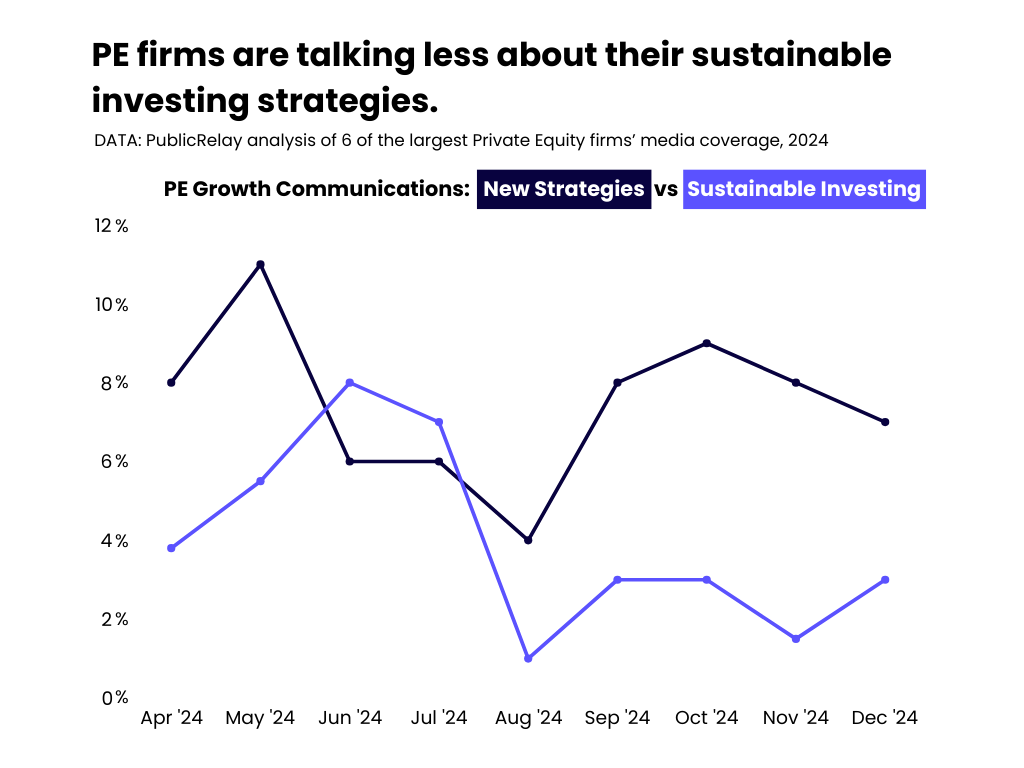The Shift in Private Equity’s Sustainability Messaging
A distinct shift is underway in private equity communications. PublicRelay’s analysis of media coverage from six leading private equity firms reveals a notable pivot: sustainability investing mentions have dropped from approximately 8% to just 3% of total messaging. Meanwhile, discussions around other growth strategies, such as AI-driven infrastructure, emerging market expansion, and wealth management, have remained steady at 6-8% of the conversation.
This trend reflects a broader recalibration in the way private equity firms communicate their role in sustainable investing. While major players continue to raise billions for climate-focused investments, they have also deployed over $1 trillion into traditional fossil fuels since 2010. The result? A strategic ‘greenhushing’, where firms carefully measure their sustainability communications amid growing political polarization and shifting stakeholder expectations.
Growth Narratives Taking Center Stage
Rather than abandoning sustainability initiatives, private equity firms are embedding them into broader market-driven narratives. Some of the key themes gaining traction include:
- AI & Data Center Infrastructure Expansion – As demand for AI-powered solutions skyrockets, the focus is shifting to the energy and computing infrastructure required to support this growth.
- Emerging Market Investment Opportunities – Capital is flowing into regions poised for rapid economic expansion, with sustainability considerations folded into risk and opportunity assessments.
- Insurance and Risk Management – Climate resilience is becoming a key factor in portfolio diversification, with private equity firms leveraging insurance strategies to mitigate environmental risk.
- Retail Investment and Wealth Management – Firms are emphasizing their ability to democratize investment access, positioning sustainable assets as one of many attractive options for a broader investor base.

The Balancing Act: Sustainability as a Strategic Asset
Private equity firms are not walking away from sustainability; they are reframing it. The focus is shifting toward:
- Market-driven opportunities – Investments that align with clear financial incentives and regulatory tailwinds.
- Demand-side infrastructure plays – Energy-efficient solutions tailored to the needs of high-growth industries.
- Integration within larger growth narratives – Sustainability investments are increasingly framed as essential components of innovation and economic expansion.
The Future Sustainability Communications Playbook
For communicators in private equity and beyond, this shift underscores the need for a more nuanced approach to sustainability messaging. To remain effective, communications and marketing leaders should:
- Balance transparency with strategic restraint – Overpromising on ESG commitments can lead to reputational risks; firms must ensure that their messaging aligns with tangible results.
- Frame sustainability within innovation and market demand narratives – Emphasize how investments in clean energy or sustainable solutions address the evolving needs of industries like AI, logistics, and advanced manufacturing.
- Anchor messaging in financial performance metrics – Demonstrating potential returns and long-term value creation helps counter skepticism and reinforces the business case for sustainability.
- Connect climate initiatives to broader economic drivers – Position sustainability as a core enabler of business growth, rather than a standalone initiative.
The Bottom Line
The winning communications strategy for 2025 is not about abandoning sustainability messaging—it’s about evolving it. Private equity firms (and other sustainability-focused organizations) must integrate climate and ESG investments into a broader, financially compelling narrative that resonates with investors, policymakers, and the public.
By reframing sustainability as an essential component of market-driven growth, communicators can ensure their messaging remains relevant, credible, and impactful in an increasingly complex media landscape.